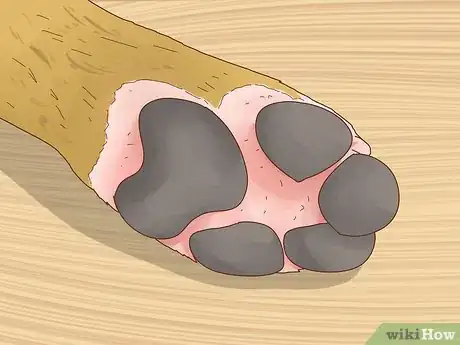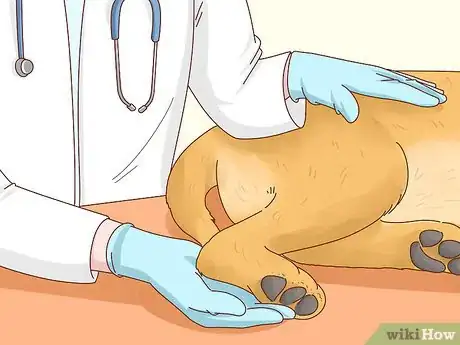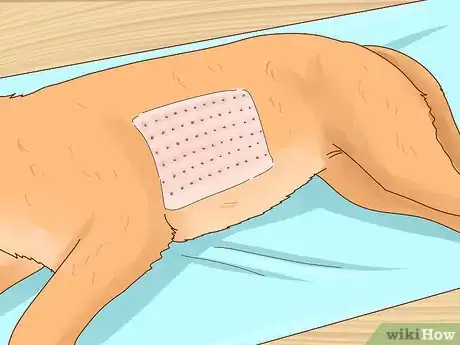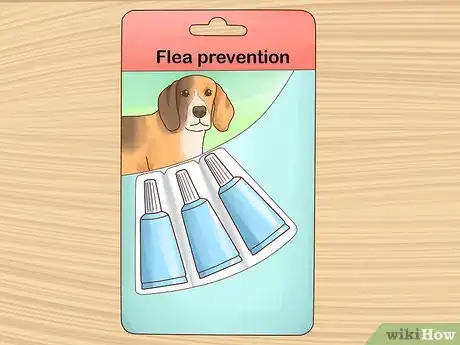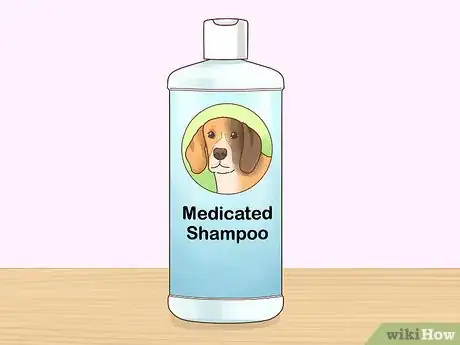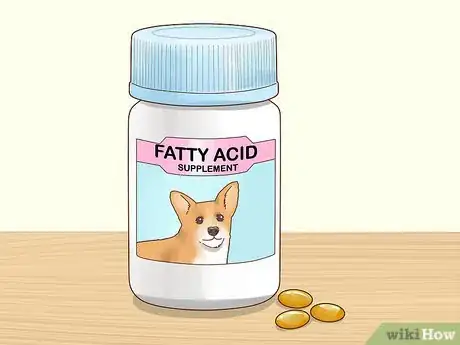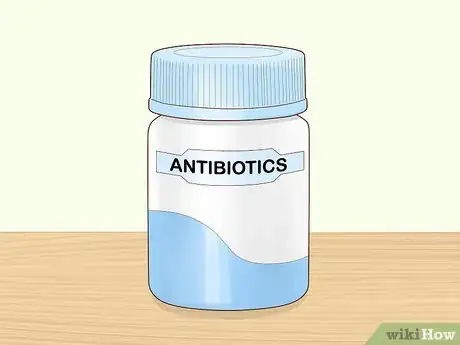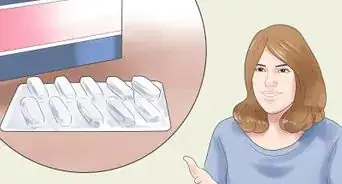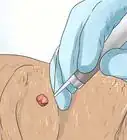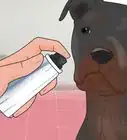This article was co-authored by Pippa Elliott, MRCVS and by wikiHow staff writer, Jennifer Mueller, JD. Dr. Elliott, BVMS, MRCVS is a veterinarian with over 30 years of experience in veterinary surgery and companion animal practice. She graduated from the University of Glasgow in 1987 with a degree in veterinary medicine and surgery. She has worked at the same animal clinic in her hometown for over 20 years.
This article has been viewed 40,538 times.
Dogs can have allergies just like humans. Allergic dermatitis is relatively common, but it can make your dog miserable. Although allergies are not curable, you can control your dog’s allergies by limiting their exposure to the allergens and by administering medications. With conscientious care, you can help your dog live a happier and healthier life.[1]
Steps
Determining the Cause of the Reaction
-
1Evaluate the locations of itching or hair loss on your dog. Sometimes you can figure out what's causing your dog's allergic reaction simply by identifying where the itchy rash develops. The condition of your dog's skin and fur also give you an idea of how severe the reaction is.[2]
- For example, if your dog has a rash around its paws, it may be allergic to grass or something else it comes into contact with when walking outside.
- A rash around your dog's rump may indicate that your dog is allergic to fleas. These areas are where fleas tend to bite most often.
Watch Your Dog's Behavior: Dogs with allergic dermatitis may show other signs of distress, such as difficulty sleeping or eating, over-grooming, or changes in normal habits.
-
2Take your dog to the veterinarian for an examination. If you suspect your dog has allergic dermatitis, a veterinarian can help you ensure that your pet gets proper treatment. While it is possible to treat allergic dermatitis at home, it's still important to have a vet examine your dog for other health issues or secondary infections.[3]
- The veterinarian will also rule out any other potential causes of your dog's rash, apart from a possible allergy.
Advertisement -
3Provide information about your dog's medical history to the veterinarian. The veterinarian will need to know as much as possible about your dog's food and environment so they can figure out potential causes of your dog's rash.[4]
- If your dog has had problems with rashes or itching in the past, let the veterinarian know. If you found a treatment that worked to eliminate a rash or itching in the past, tell the veterinarian what you did.
- Also, consider if there is a pattern to when your dog tends to have symptoms, such as if the itching is worse in the summer and improves during the winter.
-
4Get allergy tests for your dog to confirm the cause. Once the veterinarian has a good idea what's causing your dog's allergic dermatitis, they may want to do a blood or skin test to confirm their diagnosis. While allergy tests can be expensive, they can help you better determine the proper treatment options for your dog.[5]
- Allergy tests sometimes give false positives. Most veterinarians won't rely on an allergy test exclusively to make a diagnosis. However, an allergy test can confirm a diagnosis a veterinarian is already fairly confident of.
- Keep in mind that your vet will likely need to run additional tests to rule out other causes of itchiness, such as parasitic disease.
Treating the Reaction with Medication
-
1Start your dog on a flea preventative. Even if your dog doesn't go outside much or you've never seen fleas on or around it, flea prevention is essential. Flea prevention medication can be purchased online or at a pet store. These medications typically come in the form of liquid that you apply directly to your dog's skin once a month.[6]
- Apply the medication behind your dog's head, in between its shoulder blades. If your dog is rambunctious, you might want to have someone else hold the dog still while you apply the medication.
- If your dog has flea allergy dermatitis, the veterinarian may recommend a prescription flea preventative. These medications are more effective than the medications available at pet stores, and kill fleas in all life stages, including killing their eggs.
- Because preventive treatments often take several weeks before they start to have an effect, you may want to explore other short-term remedies to make your pet more comfortable in the meantime.
-
2Bathe your dog with a medicated shampoo. A shampoo with cortisol and other anti-itch medications can provide your dog relief from the itching while the rash is healing. These shampoos are available online and at pet stores.[7]
- The veterinarian may recommend a particular brand. Some veterinarians may also sell stronger treatments in their offices.
- When bathing your dog with medicated shampoo, take care not to get any of the shampoo in your dog's eyes or mouth.
Variation: If your dog doesn't tolerate baths well, a medicated bath may cause your dog more stress than relief. You can also try "hot spot" sprays, which you spray directly on the affected areas to relieve itching.
-
3Try fatty acid supplements. Fatty acid supplements have anti-inflammatory properties and can also help keep your dog from itching quite as much. These products are available in a liquid form or pill form. You can squirt drops of the liquid directly into your dog's mouth. If you aren't comfortable giving your dog a pill, you can put it in your dog's food or in a treat, such as a slice of cheese.
- If you give your dog fatty acid supplements, make sure the product is safe for dogs.
- Your dog's veterinarian may be able to recommend specific brands, or may sell products at their office that can help your dog.
-
4Get antibiotics to treat any secondary infections. Because your dog's paws and nails are dirty, it may introduce bacteria into its skin when it scratches. The irritated skin can become infected, leading to additional pain and discomfort for your dog.[8]
- When the veterinarian examines your dog, they will be able to identify any areas that are potentially infected. If warranted, the veterinarian will prescribe a round of antibiotics for your dog.
-
5Talk to the veterinarian about using prescription medications. If your dog is particularly itchy, they may need the relief that only a prescription medication can provide. Typically this medication is provided through tablets that you can give your dog at home.[9]
- Medications are a temporary measure, intended to provide your dog with short-term relief while preventive treatments start to take effect.
- Several medications are available to help control your dog’s allergy symptoms, such as apoquel and atopica.
- Ask your veterinarian about Cytopoint, which is an injectable medication that can provide relief from allergy symptoms for 4 to 8 weeks.
- You may also want to ask your vet about developing an immunotherapy injection schedule for your dog.[10]
Removing Allergens From Your Home
-
1Switch your dog to a hypoallergenic diet. Commercial dog food includes many fillers, such as corn and soy, that dogs can develop allergies to. Your dog might be allergic to a specific ingredient, such as a particular protein or carbohydrate. Putting your dog on a hypoallergenic diet for 12 weeks will allow you to determine if this is a problem.[11]
- Look for a food that includes the words "complete and balanced" on the package. This is a food with the correct amounts of protein, carbs, fat, vitamins, and minerals that your dog needs to be healthy.
- If you find a brand you're interested in, talk to your dog's veterinarian about it. In the US, you can also check on https://www.petfoodinstitute.org/about-pfi/#producer-members and see if the brand is on the list. All of these producers follow the regulations of the Association of American Feed Control Officials (AAFCO).
-
2Vacuum and use a flea-killing product on carpets and furnishings. If your dog has flea allergy dermatitis, thoroughly clean your home to remove all fleas and their eggs. Be prepared to do this several times until the fleas are eradicated.[12]
- The veterinarian can recommend flea-killing products that will eliminate the fleas at all life stages but still be safe for your pets.
- Wash your dog's bedding at least once a week. Dust covers can also help keep the bedding fresh.
-
3Try a humidifier to remove mold. Just like humans, dogs can be allergic to mold. Setting up a humidifier in your home can help clean the air and remove mold from the environment.[13]
- Setting up a humidifier may improve the quality of life for the people in your house as well.
Tip: If your dog is exposed to allergens outside, wipe its paws carefully before coming back indoors to avoid spreading the allergens inside.
-
4Change your air conditioning filter. Like humans, dogs may also be allergic to dust, pollen, and other particles in the air. Proper filtration ensures your dog won't be exposed to any of these airborne allergens.[14]
- Place activated charcoal on top of any exposed dirt in your houseplants to keep pollen out of the air.
- Use an air cleaner with a HEPA filter year round to keep the air in your home clean and fresh.
Warnings
- Unlike humans, dogs don't outgrow allergies. If your dog has allergic dermatitis, it will have the same reaction for the rest of its life. Proper preventive management is necessary to keep your dog from having additional reactions.⧼thumbs_response⧽
- If your dog is allergic to fleas, flea control and prevention is essential. Even if you don't see any fleas around your home or on your dog, they will return if you discontinue preventive treatment.[16]⧼thumbs_response⧽
References
- ↑ https://animalmedcenter.com/canine-allergic-dermatitis/
- ↑ https://animalmedcenter.com/canine-allergic-dermatitis/
- ↑ https://www.petmd.com/dog/conditions/skin/c_dg_atopic_dermatitis
- ↑ https://www.petmd.com/dog/conditions/skin/c_dg_atopic_dermatitis
- ↑ https://vcahospitals.com/know-your-pet/allergy-flea-allergy-dermatitis-in-dogs
- ↑ https://vcahospitals.com/know-your-pet/allergy-flea-allergy-dermatitis-in-dogs
- ↑ https://animalmedcenter.com/canine-allergic-dermatitis/
- ↑ https://vcahospitals.com/know-your-pet/allergy-flea-allergy-dermatitis-in-dogs
- ↑ https://vcahospitals.com/know-your-pet/allergy-flea-allergy-dermatitis-in-dogs
- ↑ https://vetmed.illinois.edu/pet_column/immunotherapy-itchy-dog/
- ↑ https://www.petmd.com/dog/nutrition/limited-ingredient-dog-food-it-right-your-dog
- ↑ https://www.banfield.com/getmedia/60cf4655-a98c-4190-8e40-6a096b70839a/4_2-Treatment-of-canine-atopic-dermatitis
- ↑ https://animalmedcenter.com/canine-allergic-dermatitis/
- ↑ https://animalmedcenter.com/canine-allergic-dermatitis/
- ↑ https://vcahospitals.com/know-your-pet/allergy-flea-allergy-dermatitis-in-dogs
- ↑ https://vcahospitals.com/know-your-pet/allergy-flea-allergy-dermatitis-in-dogs
About This Article
To treat allergic dermatitis in dogs, start by bathing your dog with a medicated shampoo that has cortisol and other anti-itch ingredients. Next, start the dog on a flea medication that you can apply directly to its skin once per month. Then, switch its food to a hypoallergenic diet and consider adding fatty acid supplements. Finally, wash its bedding weekly and remember to change your air conditioner filter regularly. For more tips on ridding your home of allergens, read on!
